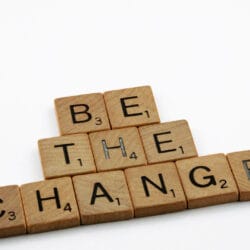What is design thinking? How to utilize it? Why it's so important to think this…
Many business practices and consumer products & services have not always been so ethical to our environment or for our wellbeing. Enter ethical design thinking.
Design thinking is a term that has been popularised in the last decade or so. Go into any medium to large-sized business today and they will have heard of design thinking, even if they don’t always know what design thinking is, or how it can really help transform the way they look at their business problems.
Yet, even for those who do understand the design thinking process, how much of that thinking is aligned with the sustainable and ethical needs of today and tomorrow?
What Is Ethical Design Thinking? And Why Is It Important?
Ethical Design Thinking might just sound like a new buzz word but it takes design thinking to a more holistic level.
Ethical design thinking is a new methodology that allows designers and product teams to focus on human values throughout their design process.
Whilst many businesses today realise the importance of having a good user experience and health-conscious offerings, they can often focus on the ‘show’ rather than on the fundamental human values underneath.
It’s not enough to just follow ‘green’ principles. Of course, cups should be biodegradable, but that shouldn’t just become our selling point to appear ethical to gain more business. We have to truly be ethical through our core values.
As ethical design thinkers, we need to consider our social responsibility in what we are designing, and how we can make a positive impact through our design.
Ethical design thinking becomes an increasingly important focus as we become a more globalised world. We vie for attention through social media and end up forgetting about ethics for profit. We have seen consumerism grow year on year as people expect to have the latest gadgets and home comforts, upgrading specs almost in competition with each other, and meanwhile forgetting about our impact on our environment, but also on how we are ingraining humanity to seek greed and comfort over values or needs.
Many of the modern dilemmas of our time are stemmed from this fueled technology-driven ideal of needing something ‘now’, without thought into why, or if we even need it at all.
It comes to a point where meetings and targets simply look for the edge over competition whether ethical or not, for immediate profit today, but which leaves a short-sightedness on what is actually good for us in the long run.
Whilst businesses will always have financial targets to achieve, we need to help them understand that in the future their best bet of achieving these targets is actually by ensuring their product and service offerings (and their entire brand message) has both forward-thinking vision and human empathic values at their core business decisions.
Instead of breeding a robotic society that relies too much on technology, making us comforted and lazy, we need to make ‘intentional choices about how we wish to allow technology to serve humanity’.
As Tim Brown, of IDEO, eloquently put, “if we design social media applications to be enticing and addictive then we are doing so because we wish for that outcome.”
Therefore, a large job of designers today is to ensure we design with intent, and with forward-minded focus.
And instead of just thinking about our selfish needs today we also need to become forward-thinking innovators who visualise what the world will need, ethically and sustainably, tomorrow.
Design Impact Is Led By Our Values
Joe Edelman, of the Time Well Spent movement, defines values as “ideas that guide us in action.” It’s about how we aim to approach things with value at the core.
For decades businesses have been focusing on the bottom line, business. ‘How can we make money? We don’t care how, we will just do it’. This approach has led towards the kind of ethical and sustainable issues we have in our world today.
Yet this same innovative drive (of the last 100 years since the Industrial Revolution) has led towards more opportunities and a safer world than at any time in history, where poverty, health, prosperity, togetherness, the availability of food, and general leisure and freedoms are at an infinitely better level than ever before.
Yet this constant progress has also led towards businesses and consumers being blinded by comfort.
Whilst it can feel that business can go on forever on a constant upward curve without considering hurdles that may come, the reality is that the more businesses have blindly moved forward the more our environment feels the strain, but arguably even more of a concern, the more people have become led by unethical approaches.
When you consider what a designer was employed to do not-so-long-ago (and even still today in some areas) it was all about making something desirable so it can become addictive. The ‘like’ button wasn’t invented by accident. It was invented by a well-to-do designer who was instructed to make a website more ‘sticky’ (so people would stay on it and make businesses more revenue).
Social media platforms are the kings of this design approach in making people stick around, and when social media first arrived no one thought about the potential dangers of that, and it’s the same today with AI.
Designers didn’t think about the biases that could exist within AI or the danger of creating something that could essentially out-think a human, but designers have begun to realise the harm in their own designing.
Just like with social media, there’s a lot of potentially positive impact that the worlds of AI, VR, and any subsequent new technology could provide us, but also a dark side if we ignore the potential consequences.
Ethical design thinking is the evolved state of thinking that ensures we are consciously considering the impact and long-term consequences of what we are designing. It’s the job of the ethical design thinker to ensure that ethical design is at the heart of their design thinking, but also to have measures in place for when the dark side tries to come out.
Ethical Design Thinking On Local Businesses
Ethical design thinking is not just a concern for larger corporations or in technology, but it should feed itself into the design and business decisions of all startups and small-to-medium-sized businesses, and even into our daily lives.
It’s about ‘solving challenges (large or small) in ways that will improve the lives of those around you‘.
Fundamentally, this is the aim of an ethical design thinker. To improve upon ourselves to benefit humanity, and there are ample ways this can be done in smaller, local businesses too.
There might not be the same tech-driven concerns in ethics, but there still is an important message that small businesses can target both through their brand and through their desire to be forward-thinking, humanity-driven and socially responsible.
Businesses today need to ensure that what they create and sell isn’t going to impact our environment negatively, but also isn’t going to impact their customer’s psyche. We might think we have to jump on the ‘sticky’ social media bandwagon of driving business through a clever viral campaign, but it’s no good if our campaign is about using happy little smoker animations that say smoking is cool again.
We have to think about the consciousness of our society, which is waking up more and more each day towards the needs of being healthy-minded and positively challenged to make a good impact in their life. Local businesses need brands to reflect this and to think about ethical impact. We can still have very successful ad campaigns that are built around good rather than shocking.
A word of warning
We have to be careful though. The more people talk about ethics the more they could actually create a barrier to innovation. Instead, we run the risk of typecasting, labeling, and creating an eggshell society that worries too much about offending someone that they simply can’t innovate or forward-think any viable solutions. Ethical design thinking is not about telling people to think this way or that way, but about ensuring we design with human values such as health, equality, trust, responsibility, identity, privacy, and longevity in mind. It doesn’t replace our design approach, it works alongside it.
The Importance Of Ethical Design Thinkers In The Business Process
An ethical design thinker is needed right from the start of a product or service’s journey.
Too often, design has been an afterthought behind profit, without companies realising that initial short-term gains only lead them to significant long-term potential losses through not being able to direct the vision and values (of their audience) from the beginning.
If we consider the value of an ethical design thinker, they can be the human-led representation of what it is people need or want. They help balance what a business wants, what technology is available, and what is ethically responsible.
If ethical design thinkers aren’t brought in from the start then businesses won’t see things from the human-centered perspective and may miss the key benefits they can provide their target audience, and the iterated ideas they can bring to the table.
If you consider how a designer created tools to be addictive such as the ‘like’ button, then a designer with human values in mind will likely be able to come up with solutions that help tackle design thinking challenges we need solving today and tomorrow.
This could be from the outdated systems in many industries that are no longer fit for purpose, to the psychological impacts certain structures have today on feeding ego or insecurity (such as the selfie culture). It’s the ethical design thinker’s responsibility to realise and combat these issues within our behavioral psychology.
We don’t just create a tool and then not expect it to have a psychological impact on the people who use it, and we don’t create a service without thinking about how that service can benefit the user’s values in some way.
We aren’t designing anymore to just persuade or subtly influence people to buy into a product or service they may or may not need, but instead, we help them make informed decisions through intentional design, through ethical design thinking.









